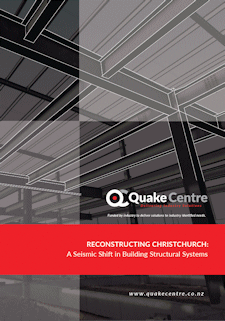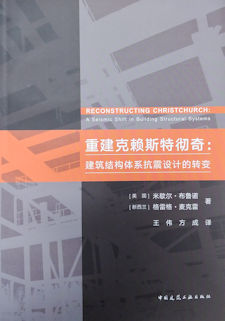Reconstructing Christchurch: A Seismic Shift in Building Structural Systems
by Michel Bruneau and
Greg
MacRae
Download the (free) recently published Quake Centre
report “RECONSTRUCTING CHRISTCHURCH” :
here
Right now. Like thousand others have done so far.
Because:
After the 2010–2011 Canterbury earthquakes, much of the Christchurch
Central Business District (CBD) was demolished, and a new city has emerged in
its place. From a structural engineering perspective, to date, the new “heart”
of Christchurch is quite different from the old one. Where reinforced concrete
buildings dominated the urban landscape, with almost all multistory buildings
relying on RC frames or walls to resist earthquake shaking, the emerging
Christchurch has a variety of structural forms, an extensive amount of steel
structures, and a number of structural systems introduced to make the new
buildings of Christchurch more seismically resilient.
This report
describes a study conducted to (a) quantify the extent to which various types
of structural system have been used in the new buildings constructed by early
2017, and (b) identify some of the drivers that have influenced decisions
about the selection of structural material and specific structural systems
used. The study involved a series of interviews with the structural designers
of more than 60% of the post-earthquake buildings constructed to date in
Christchurch’s CBD (i.e., 74 buildings), as well as with engineers from
Wellington and Auckland, an architect, a project manager, and a developer.
Data was also collected from various sources (including Christchurch’s City
Council database), and quantitative information on structural forms and
decision drivers has been assembled for the 74 buildings considered.
This report
is useful in providing insights into some of the
mechanisms that can dictate structural engineering decisions during the
post-earthquake reconstruction of a modern city.
The Christchurch experience may be unique today, but it could repeat itself in other similarly developed cities worldwide after future devastating earthquakes.
And each time history repeats itself, the price goes up.
Could your town could be the Christchurch of tomorrow?
Media Coverage
Stuff.co.nz: "Earthquakes usher in new era for steel construction"
UB Now: "Christchurch shifts from concrete to steel in post-earthquake rebuild"
2016 Interviews on Project Objectives (prior to study)
Michel Bruneau, Quake Center, University of Canterbury, February 2016
Greg MacRae, Quake Center, University of Canterbury, February 2016
Chinese Translation
 Sincere thanks to Professor Wei Wang, Professor of Structural
Engineering and Deputy Head of Department of Structural
Engineering at Tongji University, for publishing the Chinese
Translation of the Report "Reconstructing Christchurch: A
Seismic Shift in Building Structural Systems". For those who can
read Chinese, the report can be obtained from:
https://detail.youzan.com/show/goods?alias=1y43c7j6ks8q9 .
For everyone else (who must rely on Google Translate to read
Chinese characters), the original English version is still
available for free download on the weblink indicated above.
Sincere thanks to Professor Wei Wang, Professor of Structural
Engineering and Deputy Head of Department of Structural
Engineering at Tongji University, for publishing the Chinese
Translation of the Report "Reconstructing Christchurch: A
Seismic Shift in Building Structural Systems". For those who can
read Chinese, the report can be obtained from:
https://detail.youzan.com/show/goods?alias=1y43c7j6ks8q9 .
For everyone else (who must rely on Google Translate to read
Chinese characters), the original English version is still
available for free download on the weblink indicated above.
About the Authors
DESCRIPTION FROM REPORT INSERT
Dr. Michel Bruneau, Professor in the Department of
Civil, Structural and
Environmental Engineering at the
University at Buffalo, is recognized nationally and
internationally for the impact of his research contributions to
the design and
behaviour of steel structures subjected to earthquakes and
blasts. His work has
been instrumental in the inclusion in
national and international standards of
specifications for
ductile steel plate shear walls, tubular eccentrically braced
frames, ductile bridge diaphragms, and ductile composite
sandwich walls, leading
to implementation in countless
structures worldwide. For example, his development
and
validation of the tubular eccentrically braced frames concept
for bridges was
implemented in the $1B temporary supports of
the new San Francisco–Oakland
Bay Bridge. He has authored
over 500 technical publications, including over 150
articles
in the leading peer-reviewed journals in his field. He is one of
the most
cited researchers in structural engineering and
earthquake engineering. Notably,
he is the lead author of the
900-page textbook Ductile Design of Steel Structures,
used
worldwide by structural engineers and considered by many to be
the
reference for the seismic design of steel structures, and
the lead author of the
2003 pioneering paper “A framework to
quantitatively assess and enhance the
seismic resilience of
communities”, which has formulated the concept and
expression
of disaster resilience in a manner that has since driven
research in this
field. He also published four fiction books.
Bruneau has received several national awards and recognitions
for his work and
has been inducted as a fellow of the
Canadian Academy of Engineering. He is also
an ASCE
Fellow, and a member of various AISC and CSA committees
developing
design specifications for bridges and buildings.
He has conducted numerous
reconnaissance visits to
disaster-stricken areas and has served as Director of
MCEER.
He has also participated in various expert peer-review panels,
projectadvisory
committees, and special project design teams.
A detailed outline of
qualifications is available at
www.eng.buffalo.edu/~bruneau.
Gregory MacRae works at the University of Canterbury
in Christchurch, New
Zealand. He has lived through
the earthquakes and the Christchurch rebuild. After
working
in a consulting company, he has spent 30 years conducting
teaching and
research related to structural and earthquake
engineering in Japan, the USA, India
and New Zealand. Key
areas where he has initiated, or worked with others
initiating, thought change that has been recognised in standards
and practice
include: steel structure design, structural
earthquake stability and the residual
displacement
estimation, PREstressed Structural Seismic Systems (PRESSS),
displacement-based design, the continuous column concept, frame
stability, and
friction connections. In particular, his
current work focuses on low-damage
construction, decision
support tools, steel structures and structural dynamics.
Results from his studies, disseminated in publications and
keynote talks in various
countries, have influenced the
construction of many structures in New Zealand,
Japan and the
USA.
He is currently head of the Structural Engineering Cluster at
the University of
Canterbury, the New Zealand representative
to the International Association of
Earthquake
Engineering, a member of standards committees related to
earthquake
and structural steel design, and a Quake Centre
board member. Among other
activities, he has been an
associate editor for the American Society of Civil
Engineering (ASCE) Journal of Structural Engineering, the chair
of the ASCE
Seismic Effects Committee, the founder of the
Earthquake Clearinghouse after the
initial 2010 Canterbury
Earthquake, and an author for the Royal Commission on
the
Canterbury Earthquakes. He has been a director of the board of
the World
Seismic Safety Initiative (WSSI) and a senior
advisor to the board. Further
information is available at
https://sites.google.com/site/gregoryamacrae/home.
Related Interesting Media Links
Canterbury Earthquake Royal Commission
Christchurch City Council Reconstruction Plan (Final 2011 Draft)
Christchurch Central Recovery Plan
Christchurch 5 years after - from Google Earth
Christchurch 10 years after - Still empty buildings
Christchurch 10 years after - Before and After Pictures ...
Christchurch 11 years after - Still Unsettled Insurance Claims
Christchurch 13 year after - a city still under repair
Christchurch 14 year after - this is where the major Christchurch rebuild projects are at